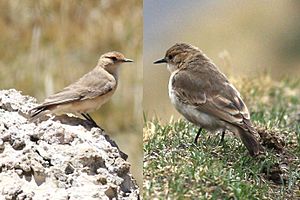Dark-winged miner facts for kids
Quick facts for kids Dark-winged miner |
|
|---|---|
 |
|
| Conservation status | |
| Scientific classification | |
| Genus: |
Geositta
|
| Species: |
saxicolina
|
 |
|
The dark-winged miner (Geositta saxicolina) is a type of bird that lives only in Peru. It belongs to a group of birds called "ovenbirds" because some of them build nests that look like old ovens!
Contents
What Kind of Bird Is It?
The dark-winged miner is a unique bird. It is the only species in its group, which means it doesn't have any close relatives that are also called "dark-winged miners."
What Does It Look Like?
The dark-winged miner is a medium-sized bird. It grows to be about 15 to 16.5 centimeters (6 to 6.5 inches) long. It weighs around 31 grams (1.1 ounces), which is about the same as a few coins.
Both male and female dark-winged miners look alike. Their forehead and face are a warm, light brown color. They have a light pinkish-brown stripe above their eyes, called a supercilium. The top of their head and their back are medium brown. Their lower back and the feathers covering their tail are a bright, light tan.
Their tail feathers are interesting! The ones closest to their body are black with a little bit of creamy tan at the bottom. The other tail feathers have more and more creamy tan. The very outer tail feathers are whitish-tan on the outside and light cinnamon-tan on the inside, with a dark band near the end.
Their wing feathers are dusky brown with lighter edges. The feathers on their belly are buff or pinkish-buff, and they are brighter on the sides of their chest. Their eyes are brown. They have a short, black beak with a gray bottom part. Their legs and feet are black.
Young dark-winged miners look a bit different. They have a warm, buffy color all over. They also have some dusky, scale-like patterns on their chest.
Where Does It Live?
The dark-winged miner is found only in the Andes mountains in central Peru. You can find it in areas like the Pasco and Huancavelica departments.
This bird lives in a high-altitude area called the Altiplano. It likes gently sloping grasslands that have lots of rocks. It lives at very high elevations, from about 3,700 to 4,900 meters (12,100 to 16,100 feet) above sea level.
How Does It Behave?
Moving Around
The dark-winged miner stays in the same area all year long. It does not migrate to other places.
Finding Food
This bird looks for its food on the ground. It often forages alone or in pairs. Sometimes, small family groups might look for food together. We don't know exactly what it eats, but we do know it eats insects. Scientists think it also eats other small creatures like arthropods and seeds.
Raising Young
Not much is known about how the dark-winged miner raises its young. We know that its nesting season includes December, but we don't know when it starts or ends. Like other birds in its group, it probably builds its nest in a chamber at the end of a burrow in the ground.
What Sounds Does It Make?
We don't know all the sounds the dark-winged miner makes. One sound, which we don't know the purpose of, is a "pretty, melodic cheecheechee-chi-chi-chi-chi." Its other sounds include "chips and very short raspy notes." When it flies, it makes a "tirr tirr tirr" sound.
Is It Endangered?
The IUCN (International Union for Conservation of Nature) has said that the dark-winged miner is a species of "Least Concern." This means it is not currently considered to be in danger of extinction.
Even though it lives in a specific area, its population size is believed to be stable. There are no immediate threats that scientists have found. People's activities probably don't have a big direct effect on the dark-winged miner. It is thought to be fairly common in its habitat.
See also
 In Spanish: Minero alioscuro para niños
In Spanish: Minero alioscuro para niños


